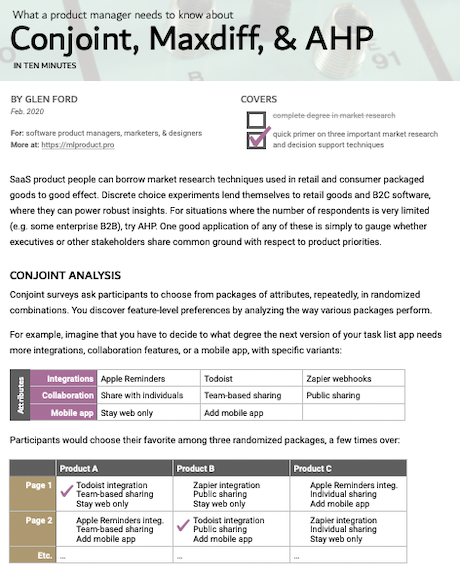SaaS product people can borrow market research techniques used in retail and consumer packaged goods to good effect. Discrete choice experiments lend themselves to retail goods and B2C software, where they can power robust insights. For situations where the number of respondents is very limited (e.g. some enterprise B2B), try AHP. One good application of any of these is simply to gauge whether executives or other stakeholders share common ground with respect to product priorities.
Download the article
Get the full article (1.3 MB PDF).
References and more
As promised in the slick, some links to software and references.
For AHP, try BPMSG!
Klaus Goepel must be the web's leading advocate for the Analytical Hierarchical Process, a technique that should be better known, and one that I've found very useful as it works well at small scales. His introduction to the technique is the best I've found, and he's made an online system for running an AHP experiment. Be forwarned: Dr. Goepel is a physicist, not a user experience maven, so the usability of that tool is, let's say, not the most intuitive. Still, if you know the complexity underpinning AHP reconciliation, it's amazing to have a tool like this. (There's also an Excel version.)
Also have a look at Transparent Choice. They also have AHP software (I've not tried it) and a blog covering some of the finer points.
Conjoint.ly
Conjoint.ly is a terrific place to learn about—and even do a trial run of—various discrete choice methods like conjoint analysis and maxdiff. (Bonus: you can even try out the Van Westendorp Price Sensitivity Meter.) Unfortunately, the software is expensive—well beyond the reach of this startup product manager. But I'm indebted to their full working freemium version.
More good resources
- Sawtooth Software also has web apps for conducting discrete choice experiments, and several helpful explainers such as: "What is the Difference Between Maxdiff and Conjoint Analysis?"
- MMR Strategy Group has more thinking on conjoint vs. maxdiff.
- Finally, you can always

